Dancers of Spring: Displaying Grouse Are a Must-See Spectacle
Lekking grouse put on stunning displays in spring. Our photo essay celebrates five of the best dancers—and we can help you plan your own bucket-list trip see these shows for yourself.
Story by Marc Devokaitis; Photos by Gerrit Vyn
March 7, 2022Many birders chase warblers come spring, but the best show in the bird world starting in March might be on the grassy plains, where grouse perform eye- and ear-catching displays: Leaps and glides that would make a modern dancer swoon, booms and pops worthy of an orchestral percussion section, and runway-ready attire that glows and transforms in the subdued light of a prairie dawn.
Five North American species of grassland grouse gather in groups during the breeding season to dance on leks—open areas of ground where males display for females. And many public and private organizations offer access and tours to viewing blinds during the height of grouse lekking activity, giving birders a front-row seat to the show.
Any trip to a lek starts with doing your homework: Four of America’s grassland grouse are listed as Near Threatened or Vulnerable by the International Union for Conservation of Nature, so it’s critical for birders to plan carefully and follow all guidelines for minimizing disturbance at leks. But play by the rules and get yourself into a lek blind well before dawn on a spring morning, and you’ll be in for an astonishing show.


Male Greater Sage-Grouse displaying on a snow covered lek in Wyoming. 

Greater Sage-Grouse hunkered down in the snow among the tops of sage bushes. Sage comprises almost 100% of the sage-grouse winter diet. 

Males display on a lek in March in Wyoming. 
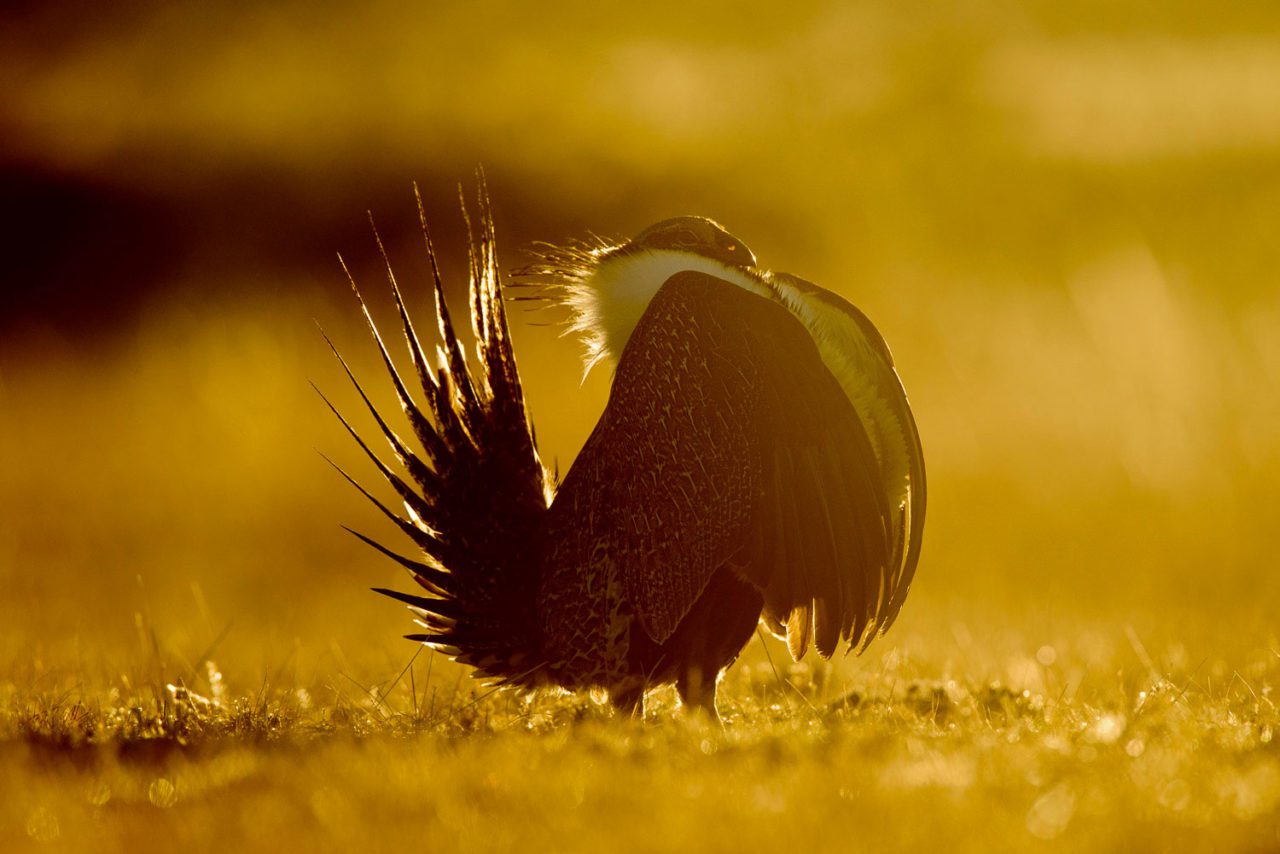
A male Greater Sage-Grouse booms on a lek at dawn. 

Female Greater Sage-Grouse gather in the center of a lek as a male displays.
Greater Sage-Grouse
During the courtship dance of the male Greater Sage-Grouse, the golden, balloonlike air sacs on its neck inflate and deflate at high speed—creating a sound like the rapid-fire popping of champagne bottles. The air-sac pops (also referred to as “plops” or “snaps”) are part of a strutting display, when males take a step or two forward, hold their tail feathers fanned in an upright position, and flare their yellow eye-comb feathers. During the display, their air sacs (technically known as cervical apteria) grow 50 times bigger as their distinctive sounds echo up to 5 miles across the open sagebrush landscape.
See the Show
Greater Sage-Grouse populations have declined significantly across western North America, but their range still spans the so-called Sagebrush Sea that runs across 10 states and two Canadian provinces. Sage-grouse leks are most active in the hours just before sunrise in the months of March, April, and May.
Wyoming
Wyoming is the stronghold of today’s Greater Sage-Grouse population, with more than a third of the world’s remaining sage-grouse living in the Cowboy State. The Wyoming Game and Fish Department offers a map of the approximate locations of 15 sage-grouse leks throughout the state; visit Wyoming’s Sage-Grouse Lek Viewing Guide, and call (307) 777-4600 to get directed to the proper Wyoming Fish and Game regional field offices for the lek you’re interested in.
California
In California, Mono County in the eastern Sierra Nevada hosts a Greater Sage-Grouse population that is geographically isolated from the rest of the species. Several accessible leks are situated on Los Angeles Department of Water and Power property in Long Valley near Mammoth Lakes. Long Valley is about 60 miles northwest of the city of Bishop and more than a 5-hour drive from all the major California cities. For viewing information and guidelines visit the Eastern Sierra Audubon Society’s Greater Sage-Grouse guide, or call Bill Deane at the LADWP, (760) 873-2283.


A strutting male Gunnison Sage-Grouse. The display and physical features of this species differ from that of the Greater Sage-Grouse in several ways. Gunnison Sage-grouse was declared a unique species in 2000. 
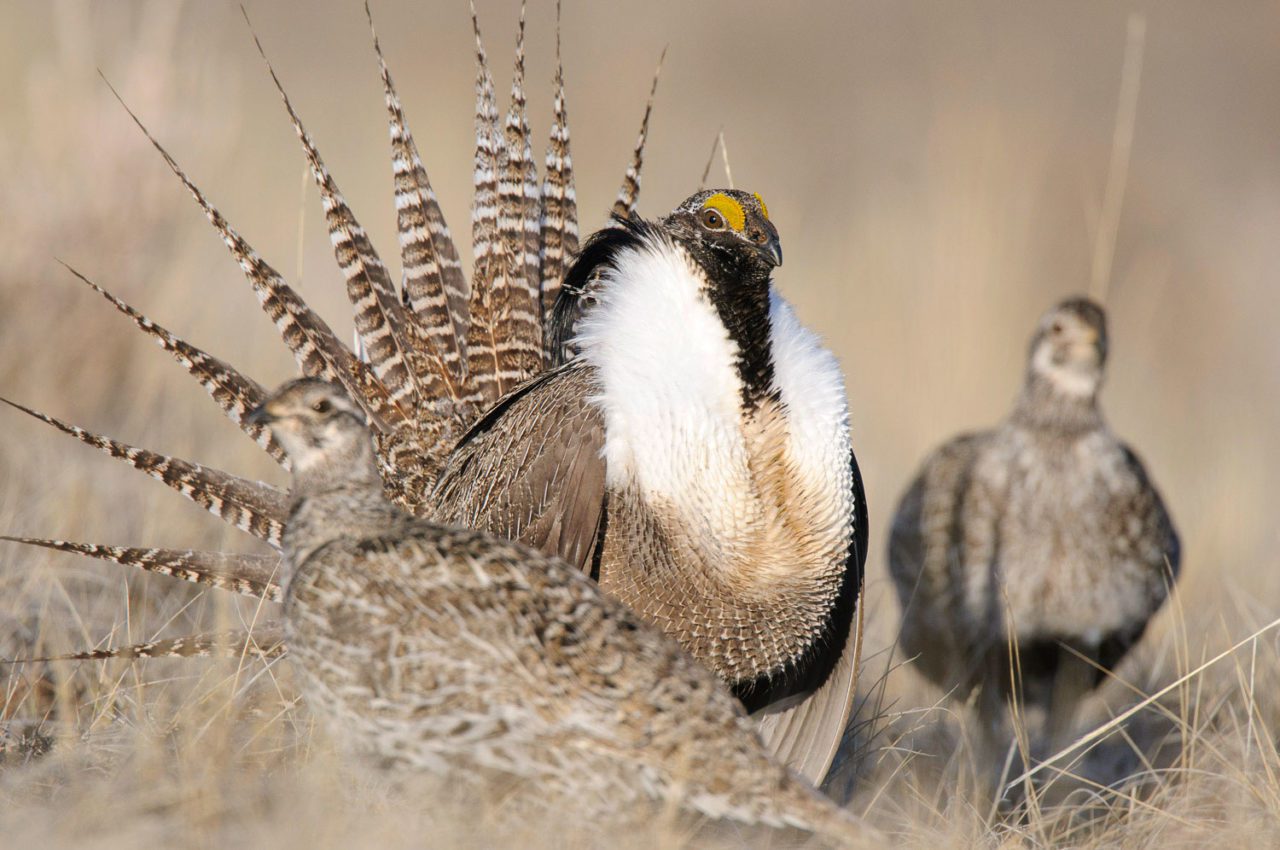
Adult male displaying at a lek in Gunnison County, Colorado. More than 90% of the world's remaining Gunnison Sage-Grouse live in the Gunnison River basin. 

A Gunnison Sage-Grouse shows off its head plumes during a display. 

A male Gunnison Sage-Grouse displays on a snow-covered lek.
Gunnison Sage-Grouse
The Gunnison Sage-Grouse looks and acts similar to the Greater Sage-Grouse, but is only 2/3 the size. The male also has extra-long filoplumes on the back of its head that recall a punk-rock ponytail. The Gunnison Sage-Grouse is very sensitive to disturbance near leks, possibly even more so than other grouse species, so birders should use extra caution.
See the Show
Colorado
Gunnison Sage-Grouse is a federally listed endangered species, and over 90% of the entire population lives in the Gunnison Basin in Colorado. The only public viewing spot for a Gunnison lek is about 20 miles west of the town of Gunnison at the Waunita Watchable Wildlife Site operated by the nonprofit conservation group Sisk-A-Dee (Shoshone for “grouse of the green river”). The 2022 viewing season runs April 1 to April 30, with no viewing from April 10 to April 16. Advance planning (sometimes one year or more in advance) is required. Visit the Sisk-A-Dee website or call director Patrick Magee (970) 641-3959.


A male Sharp-tailed Grouse displays on a lek at Ft. Pierre National Grassland in South Dakota in April. 

Displaying Sharp-tailed Grouse are reminiscent of wind-up toy airplanes. 

Male Sharp-tailed Grouse often face off along territorial boundaries within a lek. 

Male Sharp-tailed Grouse fighting on a lek. 

A male Sharp-tailed Grouse faces off against a rival male. 

Female Sharp-tailed Grouse gather in the center of a lek in South Dakota.
Sharp-tailed Grouse
When displaying, Sharp-tailed Grouse males look a bit like wind-up toy airplanes. They spread their wings, lower their heads, and point their honed, arrowlike tails toward the sky. Amidst stuttering steps and frequent direction changes, they inflate their lavender-hued throat sacs, rattle their tails, and utter a range of barks, coos, pops, and gobbles.
See the Show
Sharp-tailed Grouse tend to use the same lek sites year after year, so they can be a relatively reliable bet for seeing a spring-dancing grouse. Eastern Montana and western North Dakota host the highest densities of Sharp-tailed Grouse.
North Dakota
In North Dakota, the Upper Souris National Wildlife Refuge takes reservations for one of three blinds from early April through mid-May. Call the refuge at (701) 468-5467 or email uppersouris@fws.gov.
Montana
In Montana, the Benton Lake National Wildlife Refuge near Great Falls (more than 3 hours’ drive north of Bozeman) conducts a grouse-blind lottery each spring to allow access for birders while regulating the total number of visitors. To submit your name for this year’s lek lottery, email your top three dates to bentonlake@fws.gov, or call (406) 727-7400 ext. 226, before March 27. Blinds will be open Thursdays through Sundays from March 31 to May 15.
Nebraska
In Nebraska, the Bessey Ranger District near the town of Halsey (more than a 4-hour drive west of Omaha) sets up first-come, first served blinds on U.S. Forest Service land for Sharp-tailed Grouse viewing from mid-March through early May. Greater Prairie-Chickens can sometimes be seen there as well. Visit the Bessey NWR webpage on grouse viewing blinds or call the Bessey Ranger District at (308) 533-2257.


A Greater Prairie-Chicken displays at a vanishing lek in South Dakota. No other males were present on this morning. 

A female Greater Prairie-Chicken visits a lek at sunrise. 
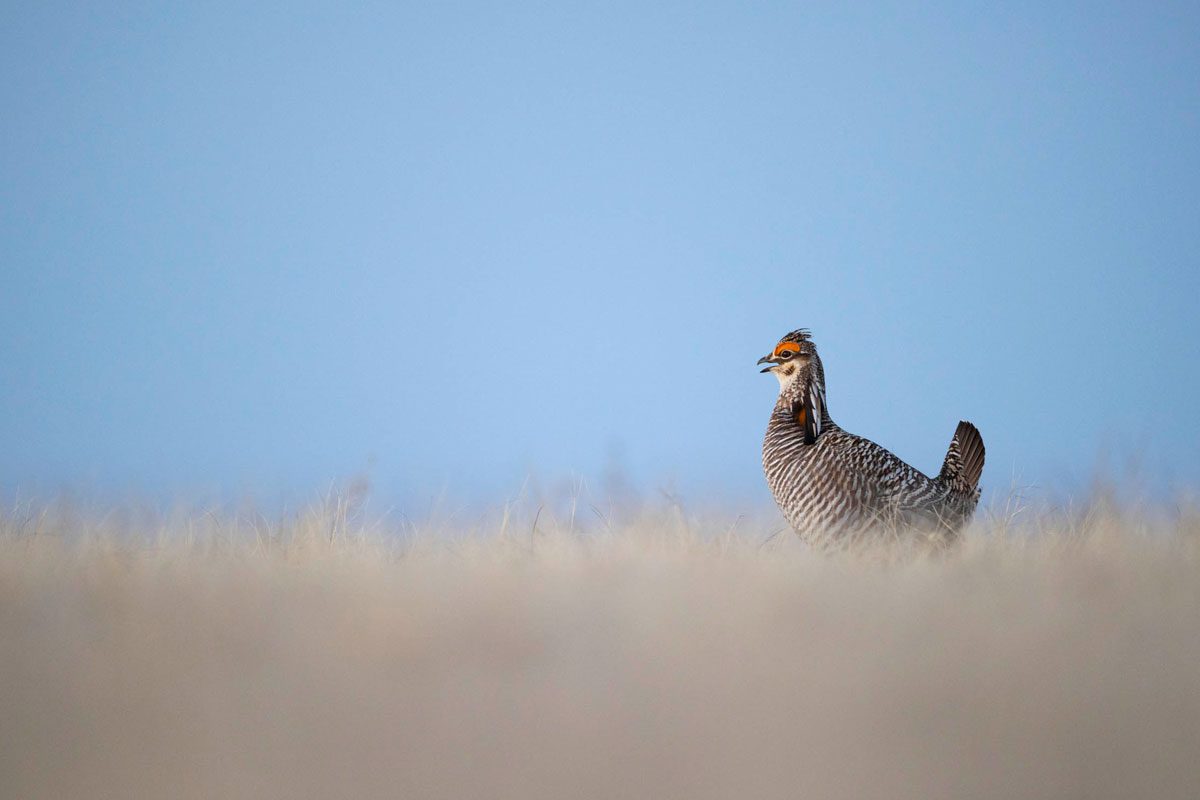
A male Greater Prairie-Chicken in a more relaxed pose. 
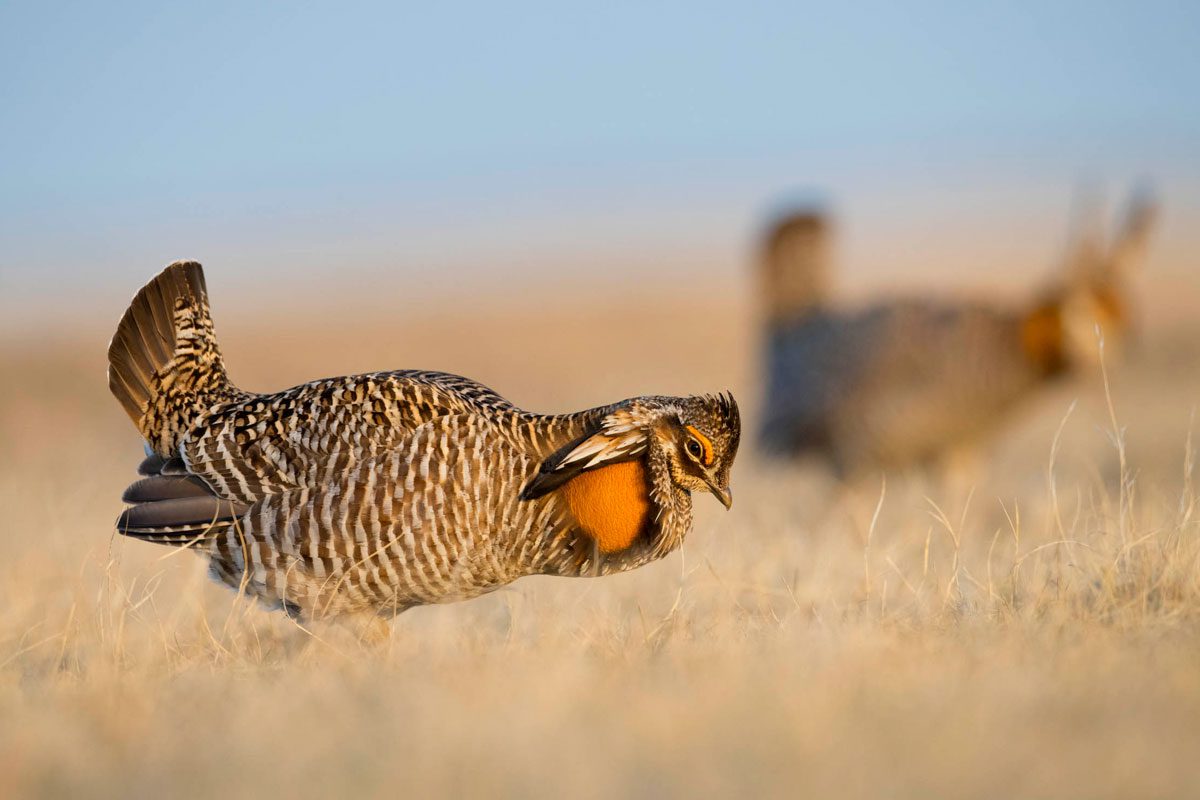
Male Greater Prairie-Chickens crouch down and rush toward rival males during the "forward rush" display. 

Two male Greater Prairie-Chickens battle on a lek in Ft. Pierre National Grassland, South Dakota. A dominant male on each lek typically performs more than 85% of copulations with females. 

A male Greater Prairie-Chicken assumes a crouched posture. 

During aggressive encounters males lower their pinnae feathers, deflate their air sacs, leap into the air, and strike their opponent with feet, wings, and/or beak. 

A male Greater Prairie-Chicken lowers its wingtips and points its tail upright during booming displays.
Greater Prairie-Chicken


A gathering of male Greater Prairie-Chickens on their booming ground sounds like wind howling through a haunted forest. But there are no trees at their lek sites amidst the prairie. Male prairie-chickens start their incessant booming in the pre-dawn darkness—rushing at each other or running in parallel along invisible territorial lines that they establish within the lek. Once females arrive, the males ramp up the intensity by performing flutter jumps, leaping several feet into the air while flapping their wings, often while uttering whoop, cackle, or whine calls.
See the Show
Greater Prairie-Chicken leks are booming from late March to early May.
Kansas
In Kansas, the Flint Hills Discovery Center in Manhattan (an hour drive west of Topeka) offers Greater Prairie-Chicken lek tours on select Saturdays and Wednesdays from mid-March through late April. Call the center at (785) 587-2726, or visit Greater Prairie-Chicken Booming Tours.
Nebraska
In southwest Nebraska, the McCook/Red Willow County Tourism Board offers guided lek tours from March through May. Call (308) 345-1200, ext. 318 or visit Prairie Chicken Dance Tours.
Wisconsin
In Wisconsin, the Paul J. Olson state wildlife area (about a 2-hour drive north of Madison) hosts the annual Wisconsin Prairie Chicken Festival on April 9. Participants will get to visit booming grounds and go on a guided grassland bird tour. Visit the Wisconsin Prairie Chicken Festival on Facebook or email wisconsinprairiechickenfest@gmail.com.
Minnesota
Northwestern Minnesota is one of the last strongholds for Greater Prairie-Chickens in the Land of 10,000 Lakes. The Minnesota Prairie Chicken Society has contact and reservation information for a half-dozen sites throughout the region.


A male Lesser Prairie-Chicken's "gobbling display" involves exposed and enlarged the eye combs, an elevated tail, and raised pinnae (ear tufts). 
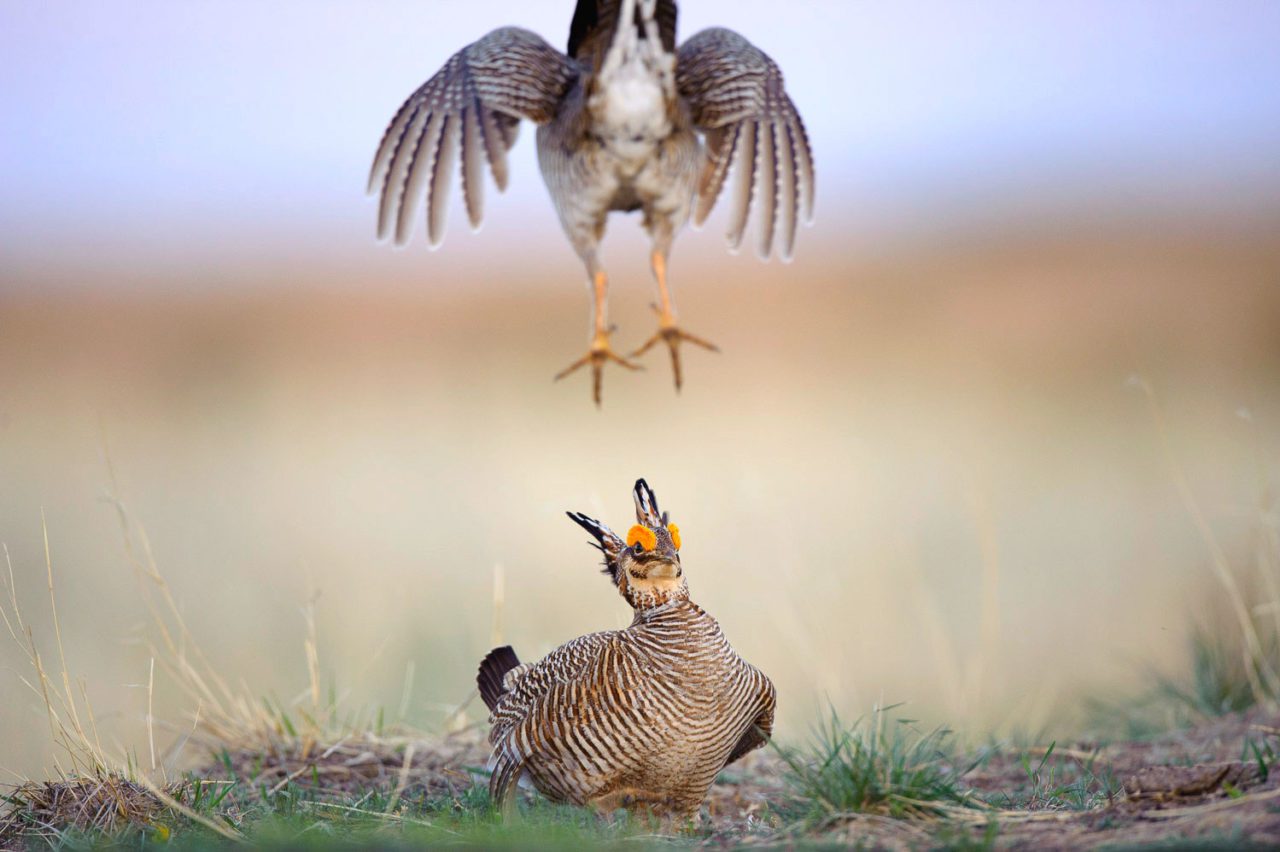
Two male Lesser Prairie-chickens facing off on a lek in Kansas. 

Male Lesser Prairie-Chickens facing off. 

An adult male Lesser Prairie-Chicken displays on a lek in Cimarron National Grassland, Kansas, in April. 

An adult male Lesser Prairie-Chicken displays on a lek in Cimarron National Grassland, Kansas, in April.
Lesser Prairie-Chicken


Sounding considerably more chickenlike than Greater Prairie-Chickens, Lesser Prairie-Chicken leks are full of gurgling gobbles and laugh-like cackles, and their leks are commonly referred to as “gobbling grounds.” During their gobbling display, male Lesser Prairie-Chickens expose their mustard yellow eye-combs, elevate their tail as high as they can, erect pinnae (earlike feathers), and extend their bodies forward and parallel to the ground. When females arrive, it stimulates the males to flutter-jump, making the lek look like an avian popcorn popper. Even females get in on the action; when several hens are concentrated in a small area on lek, they may do some of their own booming and rushing at adjacent hens.
See the Show
Lesser Prairie-Chicken leks are most active from mid-March through late April.
Kansas
Lesser Prairie-Chickens are rare and range-restricted, so there are fewer opportunities for the public to view their breeding dances, says Jackie Augustine, executive director of Audubon of Kansas. But Kansas actually offers some of the best opportunities for birders to get on a Lesser Prairie-Chicken lek. From April 7 to 10 Audubon of Kansas and partners will hold the inaugural Prairie-Chicken Festival in the town of Hays, about a 3-hour drive west of Topeka. Lek-viewing opportunities will be available for all festival attendees. Visit Audubon of Kansas online or call (785) 537-4385 for information. A little farther west in the town of Oakley, the Buffalo Bill Cultural Center offers guided tours to Lesser Prairie-Chicken leks from March 15 to May 15. Visit their website for more information, or call (785) 953-1139.


All About Birds is a free resource
Available for everyone,
funded by donors like you





